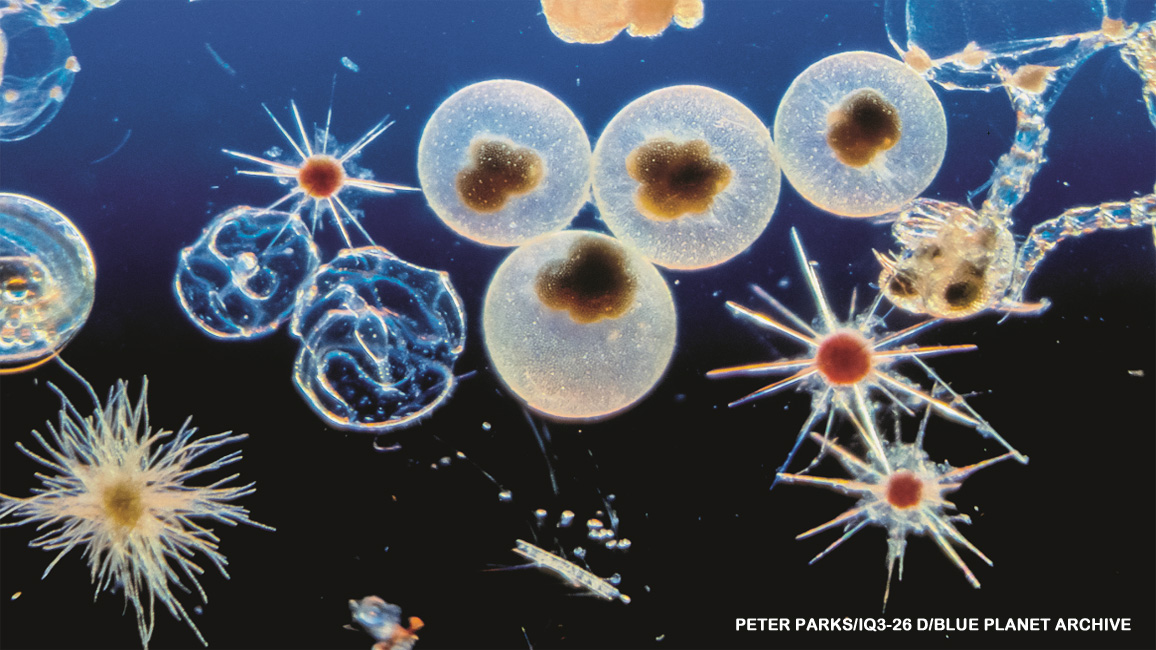
Super Small Heroes – Plankton
By Kathy KrankingThey’re not faster than a speeding bullet. And they could never leap tall buildings in a single bound. Yet all the living things you see here are superheroes, just the same.

Welcome to the world of plankton. Plankton are tiny living things that drift in the ocean. (Some kinds of plankton also live in freshwater.) Many are so small that you can’t see them without a microscope. The ones in the photo above are shown 50 times their actual size. But even though plankton are tiny, they’re some of the most important living things in the world. To the creatures whose lives depend on them, though, they’re just dinner!
There are two kinds of plankton: phytoplankton (FYE-toh-plank-tun), which are plants or plant-like things, and zooplankton (ZOH-uhplank-tun), which are tiny animals. As zooplankton drift along, they eat phytoplankton and also other zooplankton. But then bigger animals eat them. Some animals feed directly on plankton; others eat animals that eat plankton. But either way, all ocean creatures—from tiny corals to gigantic whales—need plankton to survive. So let’s hear it for plankton: the superheroes of the sea!
VIDEO: WATCH THE SECRET LIFE OF PLANKTON

WHO’S ON THE MENU?
All the plankton drifting along in the ocean make up a living “soup” for animals to eat. Some kinds of plankton spend their entire lives as drifters. But many others drift for only part of their lives. Those are the larvas, or young, of crabs, sea stars, shrimp, sponges, and other creatures. Now it’s time to eat—er, meet some plankton!
TRICKY TREAT
The glass octopus larva has a tricky trick. Most octopuses stay safe by changing color to match their surroundings. That makes it harder for predators to see them. But the glass octopus hides from predators by being almost see-through. And that’s how it got its name!
YUMMY WORM
This fuzzy-looking burrowing worm larva looks more like a stuffed animal than a worm! When it’s grown, it will settle on the ocean bottom, where it will burrow through the sand searching for tiny creatures to eat.
GLASS HOUSES
Diatoms are some of the most beautiful kinds of plankton. They have delicate shells made of a mineral called silica. People use silica to make glass. So it’s kind of like a diatom lives in a glass house.” Many creatures feed on diatoms. They’re one of the most common types of phytoplankton. A bucket of sea water may contain millions of them!
MAIN MUNCHIE
Copepods (KOH-puhpahdz) are a major menu item for lots of creatures. Any mouthful of plankton probably contains more copepods than anything else—there may be more of them on Earth than any other kind of animal! This copepod is a female carrying two blue egg cases—full of eggs that will soon hatch into even more copepods!
MIGHTY MINIS
Shrimp-like krill are found in all the world’s oceans. They’re only about the size of your pinky. But they are huge in importance. Hundreds of animals, from fish to squid to penguins to seals to whales, depend on krill to survive. Krill sometimes gather by the tens of thousands to form gigantic swarms. Some swarms are big enough to be seen from space!
CRUNCHY CRAB
This deep-sea crab larva looks more like a spider than a crab now. As crabs grow, they change form a number of times by molting, or shedding their shells. When the time is right, this one will settle
to the bottom and change one more time, becoming—and looking like—an adult crab.

WHO’S WHO IN THIS PLANKTON ZOO?
Animal that are plankton when they’re young can look very different when they’re grown. See if you can match the “baby pictures” on the left with the photos of the adults on the right.
ANSWERS: 1-D (SEA URCHIN), 2-C (SEA STAR), 3-B (BRITTLE STAR), 4-A (BARNACLE)
















